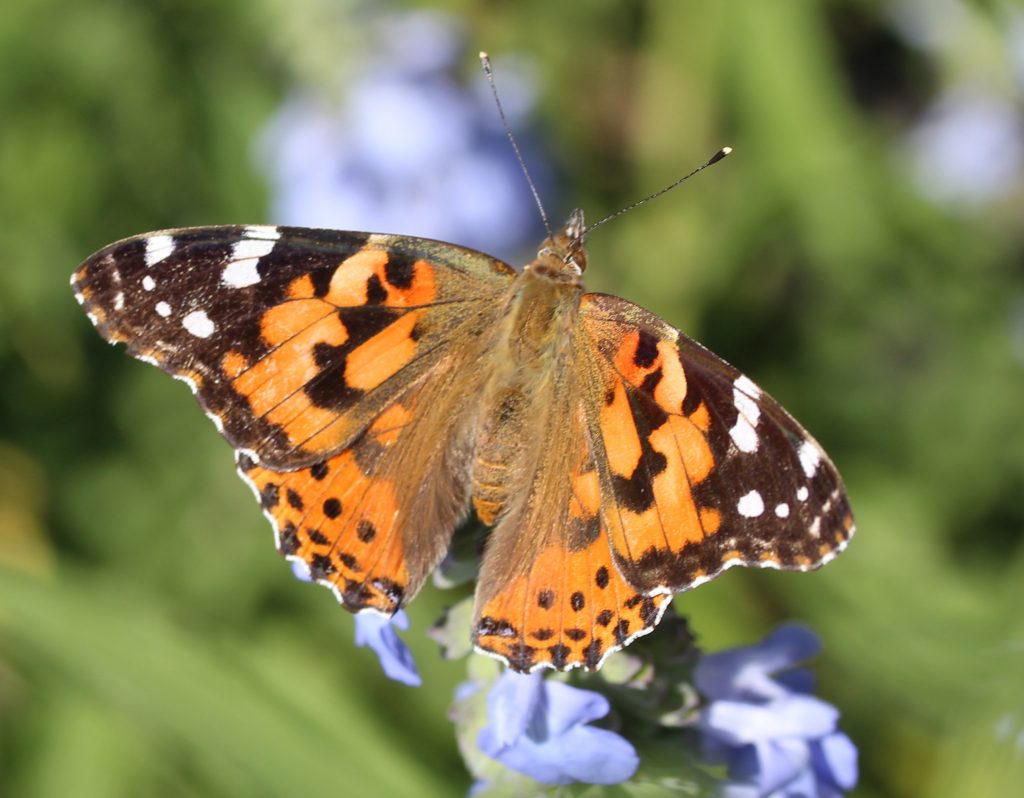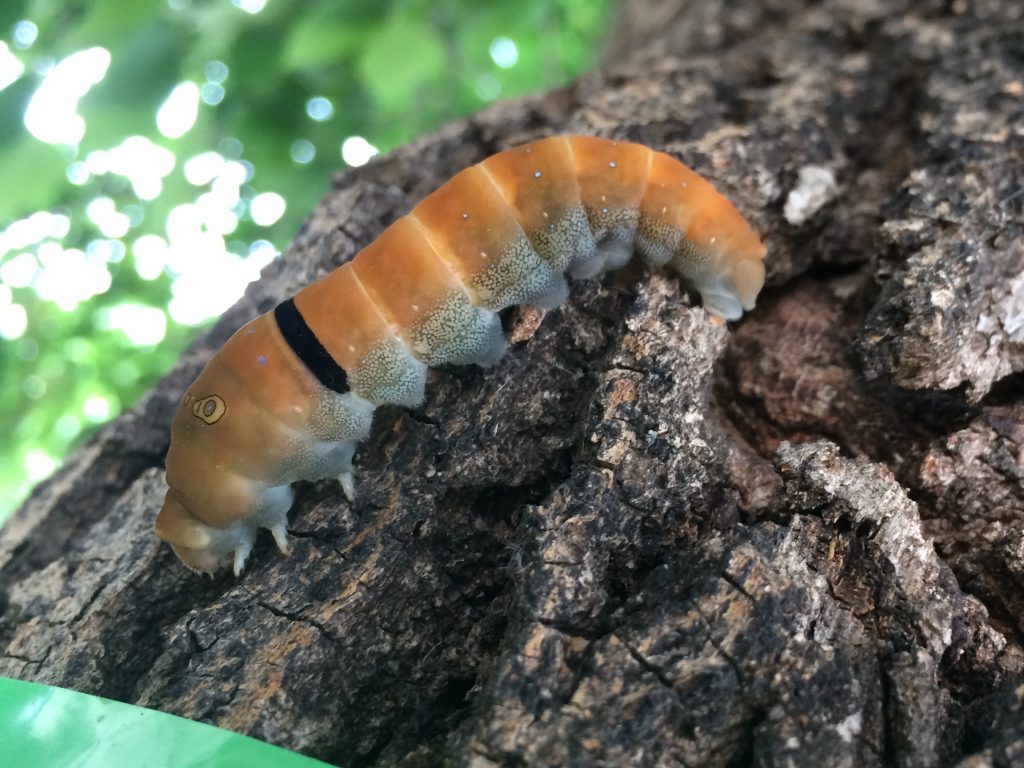The Fascinating Lives of Butterflies
- 2020-04-27
- By mkirk
- Posted in Colorado Master Gardener, Horticulture, The Garden Buzz
By Lisa Mason, CSU Extension Horticulture Agent
The season for butterflies is upon us! I have seen a few painted lady butterflies so far, but more are on their way. Last month in the Special Edition Pollinator Garden issue, I wrote a little about butterflies, but I wanted to expand on this topic because butterflies are among the most beautiful and fascinating insects in our world.
Some basic facts about butterflies and moths:
- Are part of the insect order Lepidoptera, meaning scale wing.
- Are characterized by two features: 1) their wings are covered in scales which are modified hairs, and 2) they have a proboscis which is a long, tubular mouthpart.
- Go through a full metamorphosis consisting of four life stages: an egg, larva, pupa and adult.
- Have slight variations in each individual—just like a snowflake, no two individuals are the same, but the differences are very hard to spot in the outdoors.
You can distinguish a butterfly from a moth a few different ways. Butterflies are diurnal, active during the day, while moths are generally nocturnal, active at night. Butterflies also tend to be more colorful, which helps them attract a mate. Moths attract mates through smell. Their dulled colors help them camouflage at night to avoid predators. In addition, butterflies generally have antennae that are club-shaped versus moth antennae that usually taper to a point or look feathery. Male moths, in particular, have large, feathery antennae. Moths also appear “fuzzier” than butterflies because the scales on their bodies are much thicker to keep them warm since they are mostly active at night. Butterflies rely on the sun to keep them warm. Both position their wings differently. Butterflies tend to fold their wings together, and moths hold their wings out to look more like a tent shape.
Over 250 species of butterflies can be seen in Colorado, and Arapahoe County has 127 species documented and verified.
Migration Phenomenon
One of the most fascinating things about butterflies are the migratory patterns of some species. Two migratory species of note that occur in Colorado are the monarch and the painted lady.
Monarch butterflies (Danaus plexippus) host on milkweed plants (Asclepias spp.) which contain a milky compound that is toxic to predators such as birds. The bright colors on monarch butterflies is often a warning to predators about the toxicity. The migratory corridor of monarchs are through the Midwestern US as far north as Canada, and as far south as Mexico. Monarchs also migrate up the west coast of the US. Colorado is not directly on the migratory path of monarchs, but we do see them here. Monarch butterflies use the position of the sun to navigate and a magnetic compass to orient when the days are cloudy. They possibly use a combination of both regularly. More research is needed to fully understand how monarchs navigate for the migration. More information here.

Painted lady butterflies (Vanessa cardui) are a common butterfly seen in Colorado. You may remember in 2017 when we had an explosion of painted lady butterflies in the fall! Painted lady butterflies are also a migratory species. They overwinter in the southwestern US and in Mexico. They migrate northward in the spring as plants become available. The population numbers in Colorado and surrounding areas depend on the weather in the southwestern US. When the southwest has more precipitation, the butterfly population will increase. All those butterflies then migrate northward. When the southwest has years of less precipitation, you might not see many butterflies. Painted lady butterflies are generalists and will forage on a variety of nectar-producing flowers. The caterpillars host on thistle, hollyhock and sunflowers. More information here.
A Few Other Species in Colorado

Two-tailed swallowtail butterflies (Papilio multicaudatus) are large (up to 5 inches long), yellow and are a commonly seen butterfly along the Front Range. The caterpillars feed on green ash and chokecherries. With the emerald ash borer infestation growing along the Front Range, two-tailed swallowtails may lose ash trees as potential host sites. What can you do? Plant chokecherry trees! If you choose to treat your ash tree to protect it from EAB, it is likely that trunk injections would be a safer treatment method for these butterflies rather than trunk sprays. The adults feed on nectar from thistles, milkweed and other flowers. Two-tailed swallowtails can be differentiated from tiger swallowtails by a second projection off their hindwing. More information here.
Black swallowtail butterflies (Papilio polyxenes) had a great year in 2019. They were very common in gardens along the Front Range. The butterflies are large and mostly black with some yellow markings. They host on plants in the carrot family (Apiacaea) including dill, parsley and fennel. When the caterpillars are small, their colors resemble bird droppings that can help them camouflage. As the caterpillars grow, their colors become more striking with green, black and orange markings. More information here.
Colorado hairstreak butterflies (Hypaurotis crysalus) is the Colorado state butterfly. Haven’t seen this butterfly? You are not alone. They tend to be fast fliers. These butterflies host on gambel oak, which is a common shrub in the Colorado foothills and mountains. They don’t stray too far from their host plants, even as adults. You likely won’t catch these butterflies on flowers either. They tend to feed on sap from the trees and honeydew from aphids and other insects. Some years have higher populations than others, which is most likely dependent on the weather. More information here.

Common buckeye butterflies (Junonia coenia) aren’t the most common butterfly you see in Colorado, so if you do see them, take note! These lovely butterflies overwinter in the south where the weather is warmer. Adults will migrate north to places like Colorado and will colonize over the summer months. The adults prefer flowers in the Asteraceae family including aster, gumweed and tickseed flowers. Caterpillars host on snapdragons, toadflax and plantains. More information here.
Attracting Butterflies
To attract butterflies to your backyard this summer, provide the following:
- Nectar plants that are brightly colored and have a landing pad for the adults
- Caterpillar host plants
- Sunny, open areas
- Trees and shrubs to protect them from wind and weather
- A water source such as a shallow dish
For more information, visit Attracting Butterflies to Your Garden. Visit butterfliesandmoths.org for details on what species have been documented in your area. You can find a lot of great field guides on butterflies. I recommend the Field Guide to Butterflies of North America by Jim Brock and Kenn Kaufman.
I hope you enjoy observing butterflies this summer!
Horticulture Resources
- Garden Buzz Archives
- CSU Extension Resources
- Colorado Master Gardener Program
- Foothills to Plains Native Plant Master Program
- Native Bee Watch Community Science Program
- The Co-Hort Blog
- PlantTalk Colorado
- Soil Testing
- Plant Select
- Emerald Ash Borer
- Japanese Beetle
- Colorado State Forest Service
- Ask an Expert


